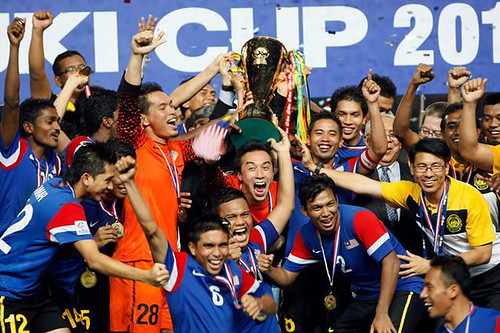Wednesday, January 26, 2011
Monetary incentives for KP2 students. Is it relevant?
Tuesday, January 25, 2011



KING OF THE PLANET!
Sunday, January 23, 2011
educational aspiration 2011
So,for the new year of 2011,would it be the same as the past? As we set our mind to aim high and achieve big as our aspirations and dreams.Can we do it? The answer is
as bob says:
To make it possible,we need to leave behind our past. Look forward to the future. Think big,act big. There are no rooms for mistakes in degree's life. We need to wake up from our honeymoon dreams during our diploma days. 'so,so lah' CGPA wouldn't take us anywhere. From now onwards,on the new year of 2011 we have set sights to achieve our goals.
Tuesday, January 18, 2011
AFC Asian Cup 2011
 | ||||||||
So,back to the main topic. All the matches will be held in five different stadiums - four in Doha and one in Ar-Rayyan. The stadiums are Khalifa International Stadium - where the opening and final game will be played,Qatar SC Stadium,Al-Gharafa Stadium,Jassem bin Ahmed Stadium and Ahmed bin Ali Stadium. So to those who are going there this january,you better start to memories all the stadiums names if you don't want to be lost. Group A contains the host,Qatar,Kuwait,China and Uzbekistan. The top two teams from each group will qualify to the next round. In this group,the pundit has picked up Qatar and Uzbekistan to go through to the quarter finals.
Group B will be represented by Japan being drawn with Saudi Arabia,Jordan and Syria. In this group Japan and Saudi Arabia will be the favorites to pass through. Group C is the group of death where the Asia's giant will be contesting against each other. They are South Korea, Australia, Bahrain and the underdogs India. The Koreans and Aussies should be able to go through easily to the next round. And the final group, group D will be a war-zone! As Iraq,Iran,North Korea and UAE are being placed in the same bowl.
The contemporary history of the world's favourite game spans more than 100 years. It all began in 1863 in England, when rugby football and association football branched off on their different courses and the Football Association in England was formed - becoming the sport's first governing body.
Both codes stemmed from a common root and both have a long and intricately branched ancestral tree. A search down the centuries reveals at least half a dozen different games, varying to different degrees, and to which the historical development of football has been traced back. Whether this can be justified in some instances is disputable. Nevertheless, the fact remains that people have enjoyed kicking a ball about for thousands of years and there is absolutely no reason to consider it an aberration of the more 'natural' form of playing a ball with the hands.
On the contrary, apart from the need to employ the legs and feet in tough tussles for the ball, often without any laws for protection, it was recognised right at the outset that the art of controlling the ball with the feet was not easy and, as such, required no small measure of skill. The very earliest form of the game for which there is scientific evidence was an exercise from a military manual dating back to the second and third centuries BC in China.
This Han Dynasty forebear of football was called Tsu' Chu and it consisted of kicking a leather ball filled with feathers and hair through an opening, measuring only 30-40cm in width, into a small net fixed onto long bamboo canes. According to one variation of this exercise, the player was not permitted to aim at his target unimpeded, but had to use his feet, chest, back and shoulders while trying to withstand the attacks of his opponents. Use of the hands was not permitted.
Another form of the game, also originating from the Far East, was the Japanese Kemari, which began some 500-600 years later and is still played today. This is a sport lacking the competitive element of Tsu' Chu with no struggle for possession involved. Standing in a circle, the players had to pass the ball to each other, in a relatively small space, trying not to let it touch the ground.
The Greek 'Episkyros' - of which few concrete details survive - was much livelier, as was the Roman 'Harpastum'. The latter was played out with a smaller ball by two teams on a rectangular field marked by boundary lines and a centre line. The objective was to get the ball over the opposition's boundary lines and as players passed it between themselves, trickery was the order of the day. The game remained popular for 700-800 years, but, although the Romans took it to Britain with them, the use of feet was so small as to scarcely be of consequence.






